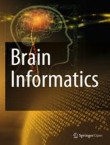Citation Impact 2023
Source Normalized Impact per Paper (SNIP): 1.543
SCImago Journal Rank (SJR): 1.016
Speed 2023
Submission to first editorial decision (median days): 13
Submission to acceptance (median days): 128
Usage 2023
Downloads: 302,950
Altmetric mentions: 141
Diagonal queue medical image steganography with Rabin cryptosystem
The main purpose of this work is to provide a novel and efficient method to the image steganography area of research in the field of biomedical, so that the security can be given to the very precious and confi...
